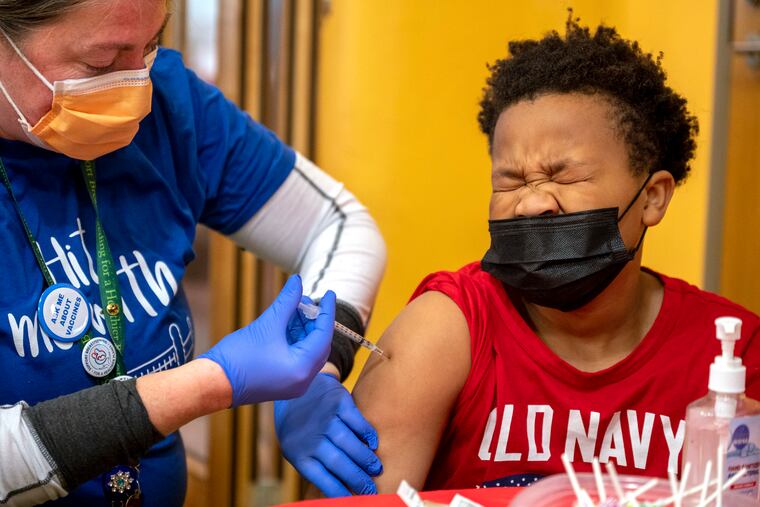As COVID-19 hospitalizations among kids increase, low flu vaccination rates add another layer of concern
Just over a third of Philadelphia children ages 6 months to 17 years have received their flu vaccines, compared to 55% in 2019

A low rate of flu vaccinations among children this year threatens to exacerbate overcrowding problems at hospitals already contending with a surge in COVID-19 cases.
Just over a third of Philadelphia children ages 6 months to 17 years have received their flu vaccines so far, compared to close to half in December last year and more than half in December 2019. About a quarter of the city’s children ages 5 to 11 have been vaccinated for COVID-19.
Statewide, half of children have received the flu vaccine as of Dec. 4, the Centers for Disease Control and Prevention reported, compared to more than 55% at this time in 2020 and 2019. In New Jersey, about 54% of children have been vaccinated, slightly below the vaccination rates the past two years. The CDC has not released adult flu vaccination rates by state for this flu season.
While the flu is less serious than COVID-19, it can lead to severe illness and even death in the elderly and in children, particularly those 5 and younger. It killed almost 200 children in 2019. Children with asthma, pulmonary, and neurological conditions are also susceptible to serious flu infections. Eleven Pennsylvanvians have died of the flu this season, the state health department has reported. New Jersey reports only pediatric flu deaths, with none so far this season.
For most healthy teens and adults, even a routine case of the flu can be debilitating.
“True influenza is a miserable illness,” said Cheryl Bettigole, Philadelphia’s health commissioner. “Shaking chills, a fever of 104 degrees, in bed for days. ... We don’t want this.”
Flu infections typically begin surging in December and continue through March. Each year, flu infects tens of millions, and annual U.S. deaths from 2010 to 2019 ranged from 12,000 to 52,000. Influenza vaccines are widely available at doctors’ offices, pharmacies, and city health clinics.
In Pennsylvania so far, 17,335 influenza cases have been confirmed, with cases highest in the southeast and northeast parts of the state. New Jersey reported 6,079 cases so far, the highest influenza activity reported for this time of the year since the 2017/2018 season.
» READ MORE: Don’t forget the flu. It’s still on the rise.
Hospitals, including pediatric facilities, are concerned about an influx of flu patients this year as they grapple with COVID-19 hospitalizations, local health officials said. Children’s Hospital of Philadelphia has had 10 to 25 COVID-19 inpatients a day in December, said Ron Keren, CHOP’s chief medical officer, compared to five to 10 daily last month. COVID-19 hospitalizations among those 17 and younger have increased 2% from the week ending Dec. 28 compared to the week before. In New Jersey, those hospitalizations are up 67% over the same time period. Meanwhile, infections from the highly transmissible omicron variant are taking hospital staff out of the workplace.
“If we superimpose on that a big wave of influenza hospitalization it could create a real problem for us,” Keren said.
In Philadelphia, more than 65,600 people have received flu vaccines this season, tens of thousands fewer than at the same time over the past two years.
In a reversal of the city’s pattern for COVID-19 vaccine administration, rates of flu vaccination among Black and Latino populations are higher than among white Philadelphians. That could be because providers have offered flu vaccines alongside COVID-19 vaccines, Bettigole said, and in recent months most of the city’s COVID-19 shots have gone to people of color.
Health officials said they didn’t believe the lower rates indicated that the anti-vaccine sentiment leading a significant minority of Americans to refuse COVID-19 inoculation is spreading to other kinds of vaccines. Routine vaccinations for children, the Philadelphia Department of Public Health reported, are roughly similar this year to pre-pandemic levels.
“As far as I’ve been able to tell, it seems to be people are just so overwhelmed with everything else,” Bettigole said. “I think it’s just that people are ... not getting motivated to do this thing they know they need to do.”
Last year, COVID-19 restrictions on travel and socializing meant flu season was virtually nonexistent. That experience, though, may have made people less aware of influenza’s annual cost. As of late November, the most current data available from the CDC, flu vaccines administered by pharmacies and doctors’ offices nationally were down 7% compared to 2019. The decline was even greater compared to 2020. Like children, vaccination rates among those with children are much reduced this year, too.
“My initial thoughts from just talking to a few people, without having flu last year, I think they’re just simply not as aware of the threat the influenza poses,” said Andrew Pekosz, a virologist at the Johns Hopkins Bloomberg School of Public Health.
» READ MORE: Penn expert raises questions about this year’s flu shots but says to get one anyway
The flu vaccine doses this year are less effective against one of the four types of influenza it is designed to prevent, and that strain, H3N2, appears to be the dominant one, the CDC reported. That flu strain is associated with more severe infections, Pekosz said. But that doesn’t mean it isn’t worth getting vaccinated. As with COVID-19 vaccines, even if the shot doesn’t stop infections, it does protect people against more serious illness.
“Even when it’s not completely matched, it has been shown to reduce severe disease in a way that’s very similar to what we’re talking about now with delta variant and the omicron variant,” Pekosz said. “It’s clear that it reduces severe disease, gives your immune system a little bit of a head start.”